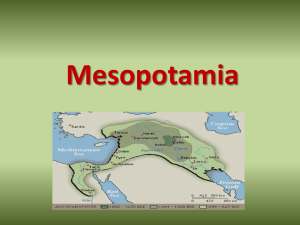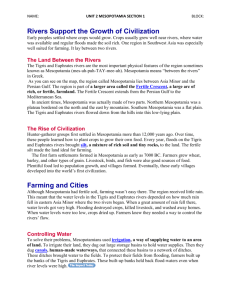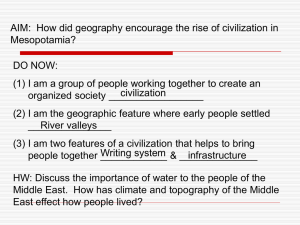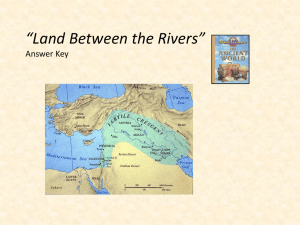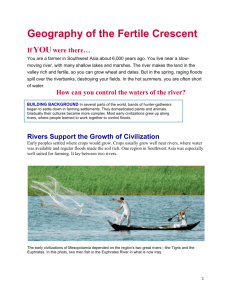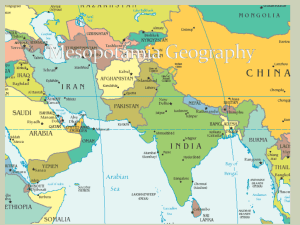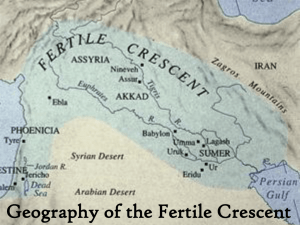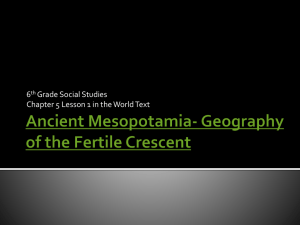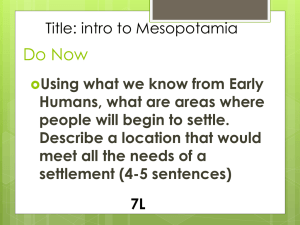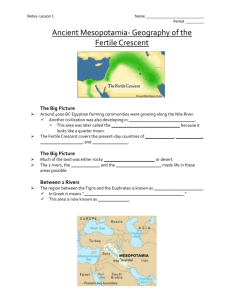Mesopotamia
advertisement
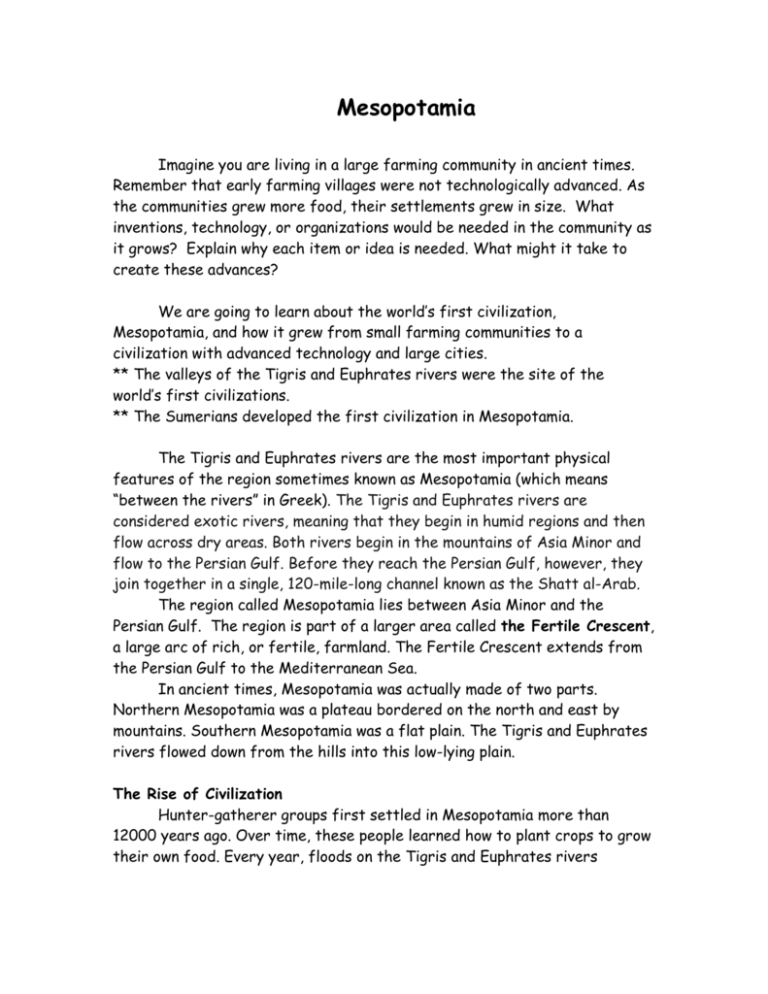
Mesopotamia Imagine you are living in a large farming community in ancient times. Remember that early farming villages were not technologically advanced. As the communities grew more food, their settlements grew in size. What inventions, technology, or organizations would be needed in the community as it grows? Explain why each item or idea is needed. What might it take to create these advances? We are going to learn about the world’s first civilization, Mesopotamia, and how it grew from small farming communities to a civilization with advanced technology and large cities. ** The valleys of the Tigris and Euphrates rivers were the site of the world’s first civilizations. ** The Sumerians developed the first civilization in Mesopotamia. The Tigris and Euphrates rivers are the most important physical features of the region sometimes known as Mesopotamia (which means “between the rivers” in Greek). The Tigris and Euphrates rivers are considered exotic rivers, meaning that they begin in humid regions and then flow across dry areas. Both rivers begin in the mountains of Asia Minor and flow to the Persian Gulf. Before they reach the Persian Gulf, however, they join together in a single, 120-mile-long channel known as the Shatt al-Arab. The region called Mesopotamia lies between Asia Minor and the Persian Gulf. The region is part of a larger area called the Fertile Crescent, a large arc of rich, or fertile, farmland. The Fertile Crescent extends from the Persian Gulf to the Mediterranean Sea. In ancient times, Mesopotamia was actually made of two parts. Northern Mesopotamia was a plateau bordered on the north and east by mountains. Southern Mesopotamia was a flat plain. The Tigris and Euphrates rivers flowed down from the hills into this low-lying plain. The Rise of Civilization Hunter-gatherer groups first settled in Mesopotamia more than 12000 years ago. Over time, these people learned how to plant crops to grow their own food. Every year, floods on the Tigris and Euphrates rivers brought silt, a mixture of rich soil and tiny rocks, to the land. The fertile silt made the land ideal for farming. The first farm settlements formed in Mesopotamia as early as 7000 BC. Farmers grew wheat, barley, and other types of grain. Livestock, birds, and fish were also good sources of food. Plentiful food led to population growth and villages formed. Eventually, these early villages developed into the world’s first civilization. Summarizing: What made civilization possible in Mesopotamia? Farming and Cities Although Mesopotamia had fertile soil, farming wasn’t easy there. The region received little rain. This meant that the water levels in the Tigris and Euphrates rivers depended on how much rain fell in eastern Asia Minor where the two rivers began. When a great amount of rain fell there, water levels got very high. Flooding destroyed crops, killed livestock, and washed away homes. When water levels were too low, crops dried up. Farmers knew they needed a way to control the rivers’ flow. Controlling Water Early farmers faced the challenges of learning how to control the flow of river water to their fields in both rainy and dry seasons. Early settlements in Mesopotamia were located near rivers. Water was not controlled, and flooding was a major problem. Later people built canals to protect houses from flooding and move water to their fields. To solve their problems, Mesopotamians used irrigation, a way of supplying water to an area of land. To irrigate their land, they dug out large storage basins to hold water supplies. Then they dug canals, human-made waterways,that connected these basins to a network of ditches. These ditches brought water to the fields. To protect their fields from flooding, farmers built up the banks of the Tigris and Euphrates. These built-up banks held back flood waters even when river levels were high. Food Surpluses Irrigation increased the amount of food farmers were able to grow. In fact, farmers could produce a food surplus, or more than they needed. Farmers also used irrigation to water grazing areas for cattle and sheep. As a result, Mesopotamians ate a variety of foods. Fish, meat, wheat, barley, and dates were plentiful. Because irrigation made farmers more productive, fewer people needed to farm. Some people became free to do other jobs. As a result, new occupations developed. For the first time, people became crafters, religious leaders, and government workers. The type of arrangement in which each worker specializes in a particular task or job is called a division of labor. Having people available to work on different jobs meant that society could accomplish more. Large projects, such as constructing buildings and digging irrigation systems, required specialized workers, managers, and organization. To complete these projects, the Mesopotamians needed structure and rules. Structure and rules could be provided by laws and government. The Code of Hammurabi – one of the oldest known collections of written laws, the Code of Hammurabi contains 282 laws dealing with matters ranging from marriage and divorce to theft and murder. The legal code, engraved on a large stone tab, was discovered in 1901 at the site of the ancient Mesopotamian city of Susa, in modern day Iran. However, historians believe the code of laws originally stood in the temple of Marduk in Babylon. The Appearance of Cities Over time, Mesopotamian settlements grew in size and complexity. They gradually developed into cities between 4000 and 3000 BC. Despite the growth of cities, society in Mesopotamia was still based on agriculture. Most people still worked in farming jobs. However, cities were becoming important places. People traded goods there, and cities provided leaders with power bases. Mesopotamian temples, known as ziggurats, served as places of worship and were the largest, most important buildings in their cities. The ruins of an ancient Sumerian temple, believed to have been built in about 2100 BC, are located near the present-day city of Nasiriyah, in southeastern Iraq. Attempts at restoring the ziggurat took place in 1930s, but only the lower level of the temple was restored. S Raw Materials: The people of Mesopotamia survived on resources provided by the Tigris and Euphrates rivers and the flat plains along the rivers. Wood, stone, and metal were almost nonexistent in the region. Without wood, buildings had to be made of clay bricks. Without stone, roads were difficult to maintain. However, by carefully using their water resources, people had enough vegetables, grains, fish, and livestock.ection 1 Assessment Linking to Today Irrigation is still a necessary part of farming. In fact, over 50 percent of all farmers today use some form of irrigation for their crops. While many farmers still use canals to direct water onto their fields, they use many other methods as well. Sprinkler irrigation and drip irrigation are two forms widely used in the United States.

